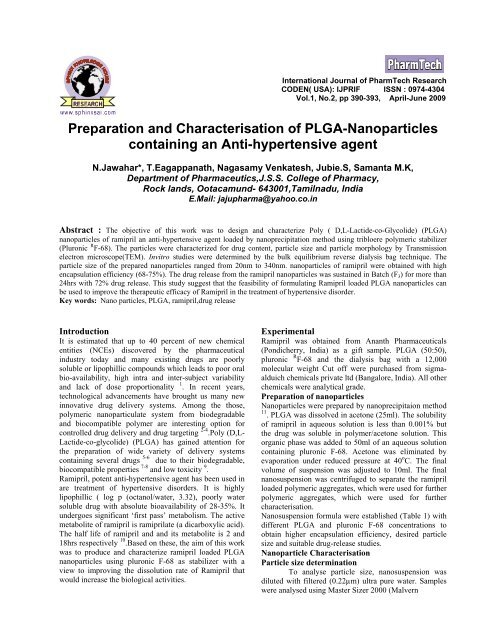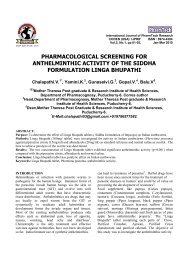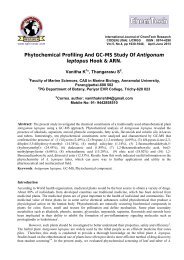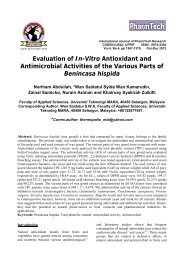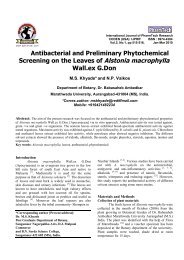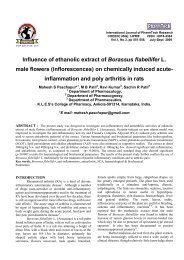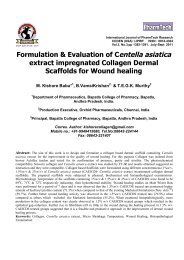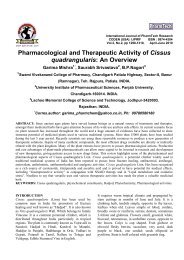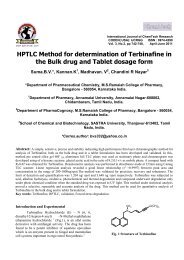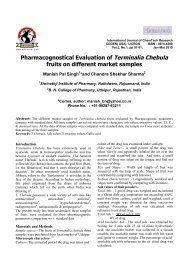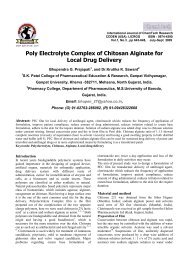Preparation and Characterisation of PLGA-Nanoparticles containing ...
Preparation and Characterisation of PLGA-Nanoparticles containing ...
Preparation and Characterisation of PLGA-Nanoparticles containing ...
Create successful ePaper yourself
Turn your PDF publications into a flip-book with our unique Google optimized e-Paper software.
International Journal <strong>of</strong> PharmTech Research<br />
CODEN( USA): IJPRIF ISSN : 0974-4304<br />
Vol.1, No.2, pp 390-393, April-June 2009<br />
<strong>Preparation</strong> <strong>and</strong> <strong>Characterisation</strong> <strong>of</strong> <strong>PLGA</strong>-<strong>Nanoparticles</strong><br />
<strong>containing</strong> an Anti-hypertensive agent<br />
N.Jawahar*, T.Eagappanath, Nagasamy Venkatesh, Jubie.S, Samanta M.K,<br />
Department <strong>of</strong> Pharmaceutics,J.S.S. College <strong>of</strong> Pharmacy,<br />
Rock l<strong>and</strong>s, Ootacamund- 643001,Tamilnadu, India<br />
E.Mail: jajupharma@yahoo.co.in<br />
Abstract : The objective <strong>of</strong> this work was to design <strong>and</strong> characterize Poly ( D,L-Lactide-co-Glycolide) (<strong>PLGA</strong>)<br />
nanoparticles <strong>of</strong> ramipril an anti-hypertensive agent loaded by nanoprecipitation method using tribloere polymeric stabilizer<br />
(Pluronic R F-68). The particles were characterized for drug content, particle size <strong>and</strong> particle morphology by Transmission<br />
electron microscope(TEM). Invitro studies were determined by the bulk equilibrium reverse dialysis bag technique. The<br />
particle size <strong>of</strong> the prepared nanoparticles ranged from 20nm to 340nm. nanoparticles <strong>of</strong> ramipril were obtained with high<br />
encapsulation efficiency (68-75%). The drug release from the ramipril nanoparticles was sustained in Batch (F 3 ) for more than<br />
24hrs with 72% drug release. This study suggest that the feasibility <strong>of</strong> formulating Ramipril loaded <strong>PLGA</strong> nanoparticles can<br />
be used to improve the therapeutic efficacy <strong>of</strong> Ramipril in the treatment <strong>of</strong> hypertensive disorder.<br />
Key words: Nano particles, <strong>PLGA</strong>, ramipril,drug release<br />
Introduction<br />
It is estimated that up to 40 percent <strong>of</strong> new chemical<br />
entities (NCEs) discovered by the pharmaceutical<br />
industry today <strong>and</strong> many existing drugs are poorly<br />
soluble or lipophillic compounds which leads to poor oral<br />
bio-availability, high intra <strong>and</strong> inter-subject variability<br />
<strong>and</strong> lack <strong>of</strong> dose proportionality 1 . In recent years,<br />
technological advancements have brought us many new<br />
innovative drug delivery systems. Among the those,<br />
polymeric nanoparticulate system from biodegradable<br />
<strong>and</strong> biocompatible polymer are interesting option for<br />
controlled drug delivery <strong>and</strong> drug targeting 2-4 .Poly (D,L-<br />
Lactide-co-glycolide) (<strong>PLGA</strong>) has gained attention for<br />
the preparation <strong>of</strong> wide variety <strong>of</strong> delivery systems<br />
<strong>containing</strong> several drugs 5-6 due to their biodegradable,<br />
biocompatible properties 7-8 <strong>and</strong> low toxicity 9 .<br />
Ramipril, potent anti-hypertensive agent has been used in<br />
are treatment <strong>of</strong> hypertensive disorders. It is highly<br />
lipophillic ( log p (octanol/water, 3.32), poorly water<br />
soluble drug with absolute bioavailability <strong>of</strong> 28-35%. It<br />
undergoes significant ‘first pass’ metabolism. The active<br />
metabolite <strong>of</strong> ramipril is ramiprilate (a dicarboxylic acid).<br />
The half life <strong>of</strong> ramipril <strong>and</strong> <strong>and</strong> its metabolite is 2 <strong>and</strong><br />
18hrs respectively 10 .Based on these, the aim <strong>of</strong> this work<br />
was to produce <strong>and</strong> characterize ramipril loaded <strong>PLGA</strong><br />
nanoparticles using pluronic F-68 as stabilizer with a<br />
view to improving the dissolution rate <strong>of</strong> Ramipril that<br />
would increase the biological activities.<br />
Experimental<br />
Ramipril was obtained from Ananth Pharmaceuticals<br />
(Pondicherry, India) as a gift sample. <strong>PLGA</strong> (50:50),<br />
pluronic R F-68 <strong>and</strong> the dialysis bag with a 12,000<br />
molecular weight Cut <strong>of</strong>f were purchased from sigmaalduich<br />
chemicals private ltd (Bangalore, India). All other<br />
chemicals were analytical grade.<br />
<strong>Preparation</strong> <strong>of</strong> nanoparticles<br />
<strong>Nanoparticles</strong> were prepared by nanoprecipitaion method<br />
11 . <strong>PLGA</strong> was dissolved in acetone (25ml). The solubility<br />
<strong>of</strong> ramipril in aqueous solution is less than 0.001% but<br />
the drug was soluble in polymer/acetone solution. This<br />
organic phase was added to 50ml <strong>of</strong> an aqueous solution<br />
<strong>containing</strong> pluronic F-68. Acetone was eliminated by<br />
evaporation under reduced pressure at 40 o C. The final<br />
volume <strong>of</strong> suspension was adjusted to 10ml. The final<br />
nanosuspension was centrifuged to separate the ramipril<br />
loaded polymeric aggregates, which were used for further<br />
polymeric aggregates, which were used for further<br />
characterisation.<br />
Nanosuspension formula were established (Table 1) with<br />
different <strong>PLGA</strong> <strong>and</strong> pluronic F-68 concentrations to<br />
obtain higher encapsulation efficiency, desired particle<br />
size <strong>and</strong> suitable drug-release studies.<br />
Nanoparticle <strong>Characterisation</strong><br />
Particle size determination<br />
To analyse particle size, nanosuspension was<br />
diluted with filtered (0.22µm) ultra pure water. Samples<br />
were analysed using Master Sizer 2000 (Malvern
N.Jawahar et al /Int.J. PharmTech Res.2009,1(2) 391<br />
instrument, UK) which allows sample measurement in<br />
the range <strong>of</strong> 0.020-2000.00µm.<br />
Polydispersity studies:<br />
Polydispersity was determined according to the<br />
equation,<br />
Polydispersity =<br />
D(0.9) - D(0.1)<br />
D(0.9)<br />
Where, D(0.9) corresponds to particle size immediately<br />
above 90% <strong>of</strong> the sample, D(0.5) corresponds to particle<br />
size immediately above 50% <strong>of</strong> the sample. D(0.1)<br />
corresponds to particle size immediately above 10% <strong>of</strong><br />
the sample.<br />
Table No.1: Formulae <strong>of</strong> Nanosuspension<br />
For<br />
mul<br />
atio<br />
Code<br />
Amt <strong>of</strong><br />
Ramipri<br />
l<br />
(mg)<br />
Amt<br />
<strong>of</strong><br />
<strong>PLGA</strong><br />
(mg)<br />
Amt <strong>of</strong><br />
Pluronic<br />
F-68<br />
(mg)<br />
Amt <strong>of</strong><br />
Acetone<br />
(ml)<br />
F 1 5 125 100 25 50<br />
F 2 5 250 100 25 50<br />
F 3 5 125 200 25 50<br />
F 4 5 250 200 25 50<br />
F 5 --- 125 100 25 50<br />
Table No. 3 Drug Content <strong>of</strong> the Formulations<br />
Amt<br />
<strong>of</strong><br />
Water<br />
(ml)<br />
External Morphological StudieS (TEM):<br />
External morphological <strong>of</strong> nanoparticles was<br />
determined using Transmission Electron Microscopy<br />
(TEM) with Philips EM-CM 12, 120 kr. Sample were<br />
prepared by placing one drop on a copper grid, dried<br />
under vaccum pressure before being examined using a<br />
TEM without being stained.<br />
Drug Content <strong>and</strong> Drug Entrapment Efficiency<br />
12,13 :<br />
The total drug amount in the suspension was<br />
determined spectrophotometrically at 207nm.Entrapment<br />
efficiency <strong>of</strong> ramipril in the nanoparticles were<br />
determined by the following formula,<br />
Entrapment Efficiency =<br />
Wt. <strong>of</strong> the drug incorporated<br />
Wt. <strong>of</strong> the drug initially taken<br />
X 100<br />
Iinvitro release Studies 14,15 :<br />
The dialysis bag diffusion technique was used to<br />
study the invitro drug release <strong>of</strong> ramipril nanoparticles.<br />
The prepared nanoparticles were placed in the dialysis<br />
bag <strong>and</strong> immersed in to 50ml <strong>of</strong> PBS (7.4). The entire<br />
system was kept at<br />
. With the continous<br />
magnetic stirring at 200rpm/min. Samples were<br />
withdrawn from the receptor compartment at<br />
predetermined intervals <strong>and</strong> replaced by fresh medium.<br />
The amount <strong>of</strong> drug dissolved was determined with UV-<br />
Spectrophotometry at 207nm.<br />
Formulation Code<br />
Drug Content (mg)<br />
F 1 3.12<br />
F 2 4.29<br />
F 3 2.94<br />
F 4 3.92<br />
Table No. 5 Entrapment Efficiency <strong>of</strong> the<br />
Formulations<br />
Formulation Code Entrapment Efficiency (%)<br />
F 1 72.14<br />
F 2 68.28<br />
F 3 77.16<br />
Table No. 4 Amount <strong>of</strong> Free Dissolved Drug<br />
in the Formulations<br />
Formulati<br />
on Code<br />
Free dissolved drug (mg)<br />
F 1 0.72<br />
F 2 0.62<br />
F 3 0.76<br />
F 4 0.68<br />
F 4 74.86<br />
Results <strong>and</strong> Discussion<br />
I.R Spectroscopy<br />
I.R. Study was carried out to confirm the<br />
compatibility between the selected polymer <strong>PLGA</strong>, drug<br />
ramipril <strong>and</strong> nanoparticles. The spectra obtained from the<br />
I.R. Studies are from 3600cm -1 to 450cm -1 . It was<br />
confirmed that there are no major shifting as well as no<br />
loss <strong>of</strong> functional peaks between the spectra <strong>of</strong> drug,<br />
polymer <strong>and</strong> drug loaded nanoparticles (1652cm -1 ,<br />
1701cm -1 , 1743cm -1 , 2866cm -1 , 1323cm -1 ).<br />
Particle Size Determination<br />
The particle size distribution curves for all the samples<br />
are unimodel. The nanoparticles size were 199nm,<br />
340nm, 189nm, <strong>and</strong> 279nm from F 1, F 2 , F 3 <strong>and</strong> F 4
N.Jawahar et al /Int.J. PharmTech Res.2009,1(2) 392<br />
respectively. The particle size dependant on <strong>PLGA</strong><br />
concentration. The small particle size <strong>of</strong> 20nm were<br />
found in batch F 3 <strong>and</strong> the largest particle <strong>of</strong> 340nm<br />
was found in batch F 2 . The data suggest that in an<br />
increase in polymer concentration increase the particle<br />
size. However the polydispersity <strong>of</strong> the nanoparticles<br />
increased with an increase in polymer concentration <strong>and</strong><br />
particle size <strong>of</strong> the nanoparticle.<br />
External Morphological Studies<br />
The External Morphological Studies revealed<br />
that maximum nanoparticles were nearly spherical or<br />
crystal . The nanoparticle size observed by TEM,<br />
correlated well with the particle size distribution<br />
measured by Mastersizer(Malvern Instrument).<br />
F 4 ) showed initial release <strong>and</strong> prolong the effect <strong>and</strong><br />
increased size <strong>of</strong> polymeric nanoparticles.<br />
FIG.1.TEM <strong>of</strong> ramipril nanoparticles<br />
Conclusion<br />
This study confirms that the nanoprecipitation technique<br />
is suitable for the preparation <strong>of</strong> ramipril nanoparticles<br />
with high encapsulation efficiency. This formulation<br />
approach can be used to improve the therapeutic efficacy<br />
<strong>of</strong> poorly soluble drugs. The change in nanoparticle size<br />
<strong>and</strong> release kinetics were affected by changes in polymer<br />
<strong>and</strong> stabilizer concentration. The sustained release <strong>of</strong><br />
drug from the ramipril nanoparticle suggest that the<br />
frequency <strong>of</strong> administration, dose <strong>and</strong> adverse effects <strong>of</strong><br />
this molecule could be reduced. We can conclude that<br />
there is large scope for improving the use <strong>of</strong> ramipril in<br />
hypertensive treatments through nanoparticle as a drug<br />
delivery system.<br />
Drug Content & Entrapment Efficiency<br />
The total drug content in nanosuspension were<br />
varied from 2.94-4.25 mg (F 1 -F 4 ). The drug content<br />
increased with an increase in the concentration <strong>of</strong> <strong>PLGA</strong>.<br />
The amount <strong>of</strong> free dissolved drug in nanosuspension<br />
ranged from 0.68-0.76 mg. This was due to the limited<br />
solubility <strong>of</strong> Ramipril in aqueous phase. The increase in<br />
<strong>PLGA</strong> concentration increase the encapsulation<br />
efficiency.<br />
Invitro Release Studies<br />
The nanosuspension (F 3 , F 1 ) showed burst release<br />
followed by sustained release. After 24hrs <strong>of</strong> dialysis in<br />
PBS (pH 7.4) the percentage <strong>of</strong> release were 73% &<br />
59%. The initial burst effect on the release <strong>of</strong> Ramipril<br />
may be due to the free dissolved drug observed with<br />
nanosuspension <strong>and</strong> higher concentration <strong>of</strong> Pluronic F-<br />
68. Moreover smaller sized nanoparticles prepared with<br />
lower amount <strong>of</strong> <strong>PLGA</strong> <strong>and</strong> high concentration Pluronic<br />
F-68 exhibited higher drug release. The other batches (F 2 ,<br />
Acknowledgement<br />
We thank Mr. Varadharajan, CECRI Karaikudi, India in<br />
carrying out TEM analysis <strong>and</strong> particle size distribution<br />
analysis <strong>of</strong> <strong>Nanoparticles</strong>.<br />
References<br />
1. T.R.Kommuru, B.Gurbey, M.A.Khan,<br />
I.K.Reddy, Self emulsifying drug delivery<br />
systems (SEDDS) <strong>of</strong> coenzyme Q 10 :<br />
Formulation development <strong>and</strong> bioavailability<br />
assessment, Int.J.Pharm.212 (2001), 233-246.<br />
2. Gr<strong>of</strong>.R, Minamitake.Y: Biodegradable long<br />
circulating Nanospheres. Science 263, 1600-<br />
1603 (1994).<br />
3. Labhastwar V.Song, C.Levy RJ: Nanoparticle<br />
drug delivery systems. Adv.drug<br />
delivery.Rev.24, 63-85 (1997).<br />
4. Sinha VR, Bansal K, Kousik R et. al: Polt-E-<br />
Caprolactone microspheres <strong>and</strong> nanospheres an<br />
overview. Int.J.Pharm. 278, 1-23 (2004).
N.Jawahar et al /Int.J. PharmTech Res.2009,1(2) 393<br />
5. E.Allemann, R.Gumy, E. Doclker, Drug loaded<br />
nanoparticles preparation methods <strong>and</strong> drug<br />
targeting tissues. Eur.J.Pharm. Biopharm. 39<br />
(1993) 173-191.<br />
6. J.M<strong>and</strong>it, M.Vert, Les polymers a base diacids<br />
lactiques et glycoliques et la deliverance des<br />
principles actifs-S.T.P.Pharma sci.3 (1993) 197-<br />
212.<br />
7. D.H.Lewis, controlled release <strong>of</strong> bioactive agents<br />
free lactide/glycolide polymers, in: M.Chasis,<br />
R.Langer (eds) Biodegradable polymers as drug<br />
delivery systems, Marcel dekkar, New york,<br />
1991, 1-41.<br />
8. S.J.Hall<strong>and</strong>, B.J.Tighe, Polymers for degradable<br />
devices. The potential <strong>of</strong> polyesters as controlled<br />
release systems, J.control.rel.4 (1986) 155-180.<br />
9. Y.Ogava, Monthly microcapsule- Depot form <strong>of</strong><br />
LHRH agonist, Leupreclin acetate: Formulation<br />
<strong>and</strong> Pharmcokinetics in animals,<br />
Eur.J.Hosp.Pharm, 2(1992) 120-127.<br />
10. Karen tu. Et.al., (2006)<br />
11. Zili Z.Sfars, Fessi. H: <strong>Preparation</strong> <strong>and</strong><br />
characterization <strong>of</strong> poly-e-caprolactone<br />
nanoparticles <strong>containing</strong> grise<strong>of</strong>ulvin. Int.<br />
J.Pharm.294.261-267 (2005).<br />
12. Chothy M.Fishbein, J.Danenberg HD et.al;<br />
Lipophillic drug loaded nanospheres prepared by<br />
Nanoprecipitation technique: effect <strong>of</strong><br />
formulation variables on size, drug delivery <strong>and</strong><br />
release kinetics.J.Control.Release 83, 389-400<br />
(2002).<br />
13. Levy M Y, Benita S: Drug release from<br />
submicronized O/W emulsion: a new invitro<br />
kinetics evaluation model. Int.J.Pharm. 66, 29-37<br />
(1990).<br />
14. Verger ML. Fluckiger L, Kim Y et.al.,:<br />
<strong>Preparation</strong> <strong>and</strong> characterization <strong>of</strong> nanoparticles<br />
<strong>containing</strong> an anti-hypertensive agent.<br />
Eur.J.Pharm. Biopharm 46, 137-143 (1998).<br />
15. Yang SC, LU LF. Cai Y et. al.,: Body<br />
distribution in mice <strong>of</strong> intravenously injected<br />
camptothecin solid lipid nanoparticles <strong>and</strong><br />
targeting effect on brain. J. Control. Release,<br />
59.299-307 (1999).<br />
*****


